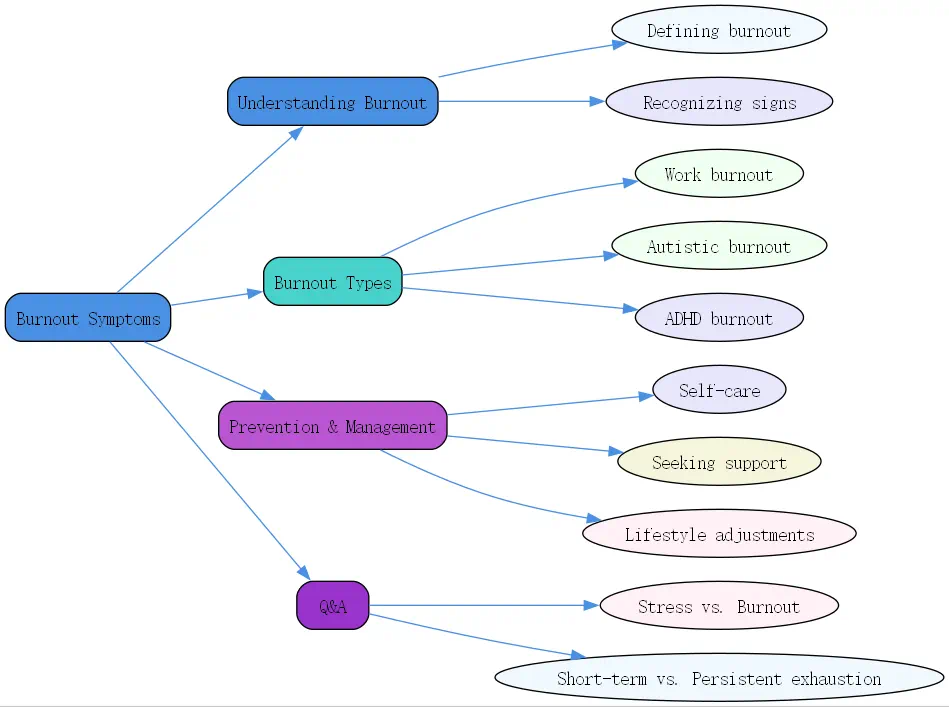Understanding Burnout Symptoms: A Comprehensive Guide

What is Burnout? Defining the Core Issue

Burnout manifests as a state of emotional, physical, and mental exhaustion caused by prolonged exposure to stress. It often stems from relentless workplace challenges, lifestyle imbalances, and individual personality traits. Unlike everyday stress, burnout siphons one’s vigor, leaving a sense of helplessness and disillusionment, and its impact can penetrate every facet of life.
- Emotional Toll: Feeling depleted and worn.
- Physical Signs: Constant fatigue and weakened immunity.
- Mental Effects: Diminished concentration and apathy.
Symptoms of Burnout: Recognizing the Signs
Recognizing burnout is pivotal. It signals when it’s time to seek intervention and adopt preventive measures to mitigate its escalation.
- Emotional Exhaustion: This is the quintessential hallmark of burnout where individuals feel drained and unable to cope.
- Cynicism and Detachment: A growing sense of detachment and cynicism towards one’s job, colleagues, and even friends.
- Reduced Personal Accomplishment: A stark decline in satisfaction and output at work.
Types of Burnout Symptoms
Work Burnout Symptoms: Specific to the Workplace
Workplace burnout is particularly damaging as it directly affects productivity and emotional well-being. Recognizing its symptoms is the first step towards addressing the underlying issues.
- Absenteeism: Increasing days off work as a coping mechanism.
- Decreased Productivity: A clear dip in performance and output.
- Interpersonal Strife: Emerging conflicts with colleagues due to stress and irritability.
Autistic Burnout Symptoms: A Neurodivergent Perspective
For neurodivergent individuals, burnout can manifest uniquely, compounding the challenges faced in daily functions and social interactions.
- Sensory Overload: Aggravation from sensory inputs can lead to overwhelming exhaustion.
- Executive Dysfunction: Struggling with organizing, prioritizing, and completing tasks.
- Increased Support Needs: A noticeable regression in abilities, requiring more support than usual.
Learn more about specialized therapy and support at BrainTalking’s dedicated [depression recovery centers.]
ADHD Burnout Symptoms: Challenges and Manifestations
Individuals with ADHD may experience intensified symptoms due to their inherent difficulties with attention and self-regulation.
- Heightened Impulsivity: Difficulty controlling impulses can lead to stressful situations.
- Emotional Dysregulation: More frequent outbursts or intense emotional responses.
- Task Management Struggles: Overwhelmed by daily responsibilities leading to incompletion and further stress.
Strategies for Preventing and Managing Burnout

Self-Care Techniques: Prioritizing Well-being
Implementing robust self-care practices is critical to fend off burnout and maintain well-being.
- Rest and Recreation: Prioritizing sleep, hobbies, and downtime to recharge.
- Setting Boundaries: Learning to say “”no”” and keeping a healthy distance from overly demanding commitments.
- Mindfulness Practices: Techniques like meditation or yoga to manage stress and enhance focus.
Seeking Support: Building a Network
Building a network of support, whether personal or professional, can provide necessary tools and understanding to manage burnout effectively.

- Open Communication: Talking to employers and loved ones about your needs.
- Joining Groups: Engaging with support groups or therapy for shared experiences and advice.
- Requesting Accommodations: Advocating for necessary workplace adjustments to reduce stress and improve productivity.
Long-Term Prevention: Lifestyle Adjustments
Long-term strategies ensure sustained prevention of burnout by integrating healthy habits and perspectives into one’s lifestyle.
- Balanced Lifestyle: Striving for a harmony between personal life and work commitments.
- Coping Mechanisms: Developing and refining stress management techniques tailored to personal needs.
- Self-compassion: Embracing imperfections and treating oneself with kindness and understanding.
Q&A Section
Question: How can I differentiate between regular stress and burnout?
Answer: Regular stress is typically short-term and situation-specific, often resolved with the conclusion of its cause. Burnout, on the other hand, is characterized by persistent feelings of exhaustion, cynicism, and inefficacy that permeate various aspects of life, demanding more comprehensive measures for relief and recovery.




